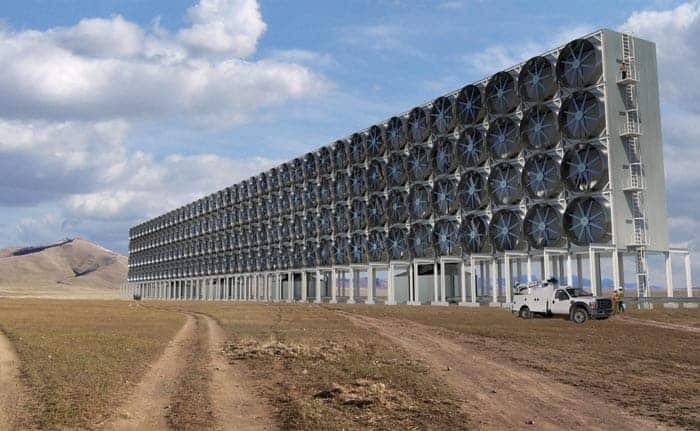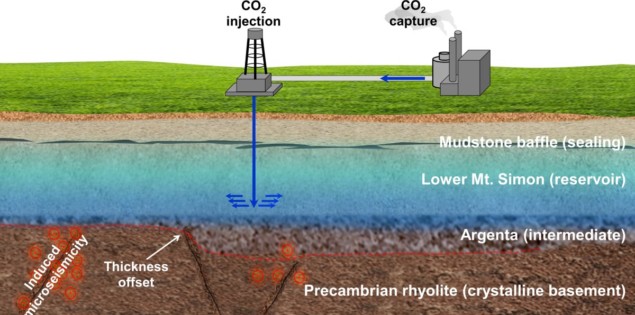Microscale structure of rock affects microseismicity at underground carbon dioxide storage site
24 Nov 2022 Sabrina Reichert
Underground storage: illustration of the geological strata at the Illinois Basin Decatur Project in the US. (Courtesy: N Bondarenko, Y Podladchikov & R Makhnenko/Science Advances)
Mitigating and reversing the effects of climate change is the most important scientific challenge facing humanity. Carbon sequestration describes a range of technologies with the potential to reduce the concentration of carbon dioxide (CO2) in the atmosphere. Most of these schemes involve storing the gas underground, however, this is not without risk, and scientists are concerned that underground storage could lead to increased seismic activity (a phenomenon known as “induced seismicity”).
Now, researchers in the US and Switzerland have studied microseismicity, the small seismic events caused by carbon injection into host rock, at the Illinois Basin Decatur Project (IBDP) in the midwestern US. In 2011–2014, the IBDP injected one million tonnes of CO2 into an underground reservoir just above a rhyolite crystalline basin. Nikita Bondarenko and Roman Makhnenko at the University of Illinois and Yury Podladchikov at the University of Lausanne have used a combination of field observations and computer simulations to show how microseismicity at the IBDP is highly dependent on the microscale structure of the host rock.
Mohr’s circle
The foundation of the researchers’ approach is a concept called “Mohr’s circle,” which describes the graph that can be drawn to depict a stress tensor. Integral to many geoengineering endeavors, Mohr’s circles can be plotted to describe the response of soils, minerals, and other geophysical materials to stress in multiple directions. The goal of the researchers was to develop a deeper understanding of the local microseismicity, considering only events of magnitude 2.0 or less on the Richter scale, during the injection of CO2 into the IBDP rock reservoir.
To complement their Mohr’s circle calculations, the group has considered how the CO2 behaves as a fluid and fills the cracks and pores of the host rock. Their results from the observation of the IBDP’s seismic activity indicate that the injection of CO2 into the “crystalline basement” (the rock layer below a sediment deposit) can exacerbate existing cracks and faults, thereby destabilizing the basin. In addition, injection-induced cracking can occur in the rigid layer directly above the crystalline basement, also known as the “stiff competent layer.”
At IBDP, CO2 is injected into the lower unit of Mt. Simon sandstone within the stratigraphy of the Illinois Basin (see figure). Due to the presence of intraformational seals (impermeable mineral veins in the rock) in the Mt. Simon complex, the injected CO2 affects the faults in the crystalline basement beneath the reservoir, making possible the reactivation of any fault structures that are favorably oriented.
Poroelastic effect
Another phenomenon that needs to be addressed during CO2 injection is the pororoelastic effect, which is related to pore pressure and mechanical stress. This part of the study focused on Argenta sandstone and Precambrian rhyolite from the T.R. McMillen #2 well, which is 25 km southwest of the IBDP injection site. The goal was to measure the site’s poromechanical properties. Cores of Argenta sandstone and Precambrian rhyolite were both extracted within the depth range of 1900–2000 m.
Precambrian rhyolite, the crystalline basement rock, is known to have fractures that permit internal fluid migration, thereby weakening the rock and lowering its elastic modulus. Intact, or heterogeneous, samples were obtained via lab-scale experiments on the specimen with size on the order of 10-100 mm. The measurements obtained on this minuscule scale were then run through the team’s “fully coupled hydromechanical numerical code,” based on the set of partial derivative Biot equations for pore fluid and behavior, to model the seismicity induced by CO2 injection at the IBDP.
Numerical modellingREAD MORE

In addition to laboratory measurements, some numerical modeling was done to relate the stratigraphy of the sandstone and rhyolite to the microseismicity taking place at the injection site. Results of seismic surveys conducted by the Illinois State Geological Survey show some uneven sedimentation in the stratigraphic layers below IBDP, which might result in a change in the stress within the rock. In addition, the strength of the rock was measured, and comparison of the friction angle to the tangent line to Mohr’s circle allowed the researchers to understand the threshold for injection-induced cracking and rock failure. In short, they conclude that the injection of CO2 is unlikely to result in significant seismic activity.
The researchers describe their results in Scientific Reports, and the main takeaway from their paper is that seismicity is a highly complex phenomenon. Local stratigraphic features complicate the analysis of injection-generated seismicity. As a result, the IBDP injection site cannot be effectively described by a single Mohr’s circle, nor can a microseismic response be explained only by the changes in pore pressure. Hydromechanical coupling, two-phase flow, stratigraphic effects, and temperature must be considered as part of the bigger picture of the IBDP’s seismicity profile. Indeed, more work must be done to reconcile the need for carbon sequestration with the continued prevalence of industry; seismicity portends a safety hazard, which impacts people’s perception of carbon sequestration measures. Until we reach a better understanding of induced seismicity from carbon injection, hazard mitigation is the best course of action.

Sabrina Reichert is a PhD student contributor to Physics World. She is pursuing a PhD in geosciences/geophysics at SUNY Stony Brook. Find out more about our student contributor networks
from physicsworld.com 7/12/2022

Δεν υπάρχουν σχόλια:
Δημοσίευση σχολίου